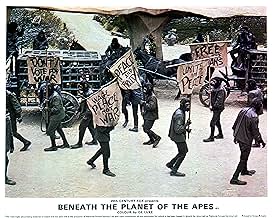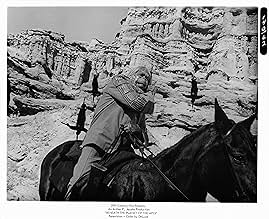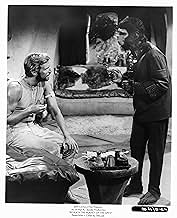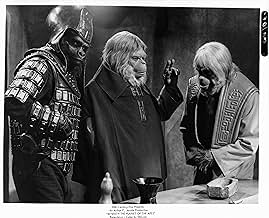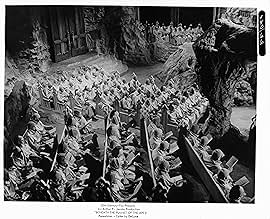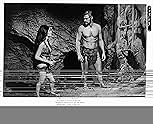Le Secret de la planète des singes
- 1970
- Tous publics
- 1h 35min
Taylor et Nova parcourent la «Planète des singes». Un nouveau vaisseau est envoyé sur la planète mais il s'écrase. Le seul survivant rencontre Nova. La planète est dominée par les singes à l... Tout lireTaylor et Nova parcourent la «Planète des singes». Un nouveau vaisseau est envoyé sur la planète mais il s'écrase. Le seul survivant rencontre Nova. La planète est dominée par les singes à l'exception d'une mystérieuse société souterraine.Taylor et Nova parcourent la «Planète des singes». Un nouveau vaisseau est envoyé sur la planète mais il s'écrase. Le seul survivant rencontre Nova. La planète est dominée par les singes à l'exception d'une mystérieuse société souterraine.
- Réalisation
- Scénario
- Casting principal
- Récompenses
- 1 nomination au total
- Lucius
- (images d'archives)
- Gorilla
- (non crédité)
Avis à la une
Kim Hunter, Maurice Evans, Linda Harrison, and Charlton Heston return for this first sequel. And James Franciscus is the only survivor of a rescue ship sent after Heston and his crew. Of course he finds the same simian civilization that Heston found and with the same problems and friends among the apes.
Franciscus goes into the forbidden zone that Heston entered, but now the apes have a military chieftain who wants to enter and conquer the previous forbidden zone. He's played by a thuggish James Gregory.
Maurice Evans is the scientist who has a vested interest in keeping the ape orthodox traditions inviolate. He doesn't want to go into the forbidden zone where Heston and Franciscus have gone, but the force of public opinion is working against him. He tags along with Gregory's military expedition to watch out for their culture.
Of course there are humans there and of a higher order than the simple creatures who were thought to be below the simian on this planet. What happens when they encounter those humans is for you to see the film for.
No doubt the force of public opinion influenced 20th Century Fox to make this sequel. Today's sequels to popular films are the result of certain teaser questions put into the plots of the originals. That was not done back then clearly because of some rather clumsy writing in Beneath The Planet Of The Apes. And certainly the ending here did not anticipate yet another sequel.
Despite that though a lot of good social commentary about the world and America got into this film, maybe even more than in the original Planet Of The Apes. Nobody could mistake the protests of the young chimpanzees to the military expedition for anything else, but criticizing the war in Vietnam and Nixon's incursion into China.
As in the first film my favorite is foxy Maurice Evans, protector of the orthodox ape religion and culture. Fans of the series will be pleased with him and the film.
The problems originated from the fact that Charlton Heston gave a flat refusal to starring in the sequel, eventually being talked into working on the film for two weeks total as long as his character of Taylor died. So, the writer and director decided that the best way forward was to give us a new astronaut, Brent, who had followed Taylor into deep space and ended up in the same place at the same time. That means that all of the revelations about the planet need to happen again to a character who's a full movie behind the audience. He finds Nova, follows her to Ape City where he discovers the upside down nature of the place, meets Zira and Cornelius for reasons, and then escapes again. At the movie's halfway point, he ends up in an abandoned New York City subway station and has his revelation in much smaller and less visually impressive environs than Taylor got at the end of the previous film.
Along with this action is some really ill-defined brewing conflict between the apes led by Dr. Zaius and General Ursus, a gorilla, and the Forbidden Zone. There's a line of dialogue about how scouts had gone missing which seems to be the sole motivation for taking an entire army into the Forbidden Zone, and it's thin stuff. The thing is that Dr. Zaius spoke in ways, at the end of the first movie, that seemed to indicate that the ruling class of the ape society knew a lot more about history and the Forbidden Zone than they told everyone else. It would have been easy enough to make the connection that Zaius knew of the mutant humans under the ruins of New York City, but not in any great detail, and assumed that Taylor was part of them, creating the argument that the mutants were expanding into ape territory, providing the impetus for the entire action. As it is, we spend so little time with them and so much time with Brent discovering what the audience already knows, that it all ends up as thin as possible.
The movie doesn't even really feel like a sequel until the second half once Brent and Nova go deeper into New York City through the subway. It feels like that's the actual beginning of the movie, and it should have been Taylor going in instead of this new character Brent. And the second half of the film has a bunch of stuff that I love. The mutants who worship an atomic bomb? Yes, please. I love that. They're wearing masks that look like real skin to hide their mutated selves beneath? It doesn't make a whole lot of sense, but I love it. The religious ritual that's held in the remnants of St. Patrick's Cathedral and uses Catholic prayers with bomb and fallout replacing any mention of God? I love it even more. It's the exact kind of twisted stuff that 60s and 70s science fiction excelled at. Another thing that that era of science fiction loved was nihilism (which made Star Trek stand out because it was hopeful in a sea of nihilistic science fiction), and the movie ending with Taylor blowing up the world because screw it, it all sucks, is something I love.
Not everything in the second half is great, though. The use of Brent requires a late introduction to Taylor that feels out of place. There's a fight scene that doesn't really work for me. And, most important of all, the conflict between ape and mutant was so thinly established that when the gorilla army shows up and attacks, it feels really empty. There are some surprisingly great visuals here like when the gorilla army is marching into St. Patrick's with the sole remaining mutant standing before the golden doomsday bomb, but they're empty because, again, the conflict itself is empty.
And, to top it off, I think that the inclusion of Brent wasn't just unnecessary from a storytelling perspective, but it was unnecessary from a production perspective as well. Some judicious use of body doubles and scheduling could have gotten Charlton Heston to carry his part of the movie completely in just a couple weeks of filming. The thing is that the ape society stuff needed to stand on its own without a human involved, having Taylor get lost in the mutant city early, spending time with Dr. Zaius to convincingly build the conflict with the mutants in the Forbidden Zone, and then leaning into the conflict as a continuation of the damnation of humanity that is the first film. I think it could have worked really quite well if there wasn't a need to remake the film unnecessarily in the first half.
Oh well, it's a mixed bad, but it definitely has stuff that works. Unfortunately, that stuff is outnumbered by the more mediocre material that supports it. It's far from one of the worst sequels to a great film ever made. It has too many interesting ideas and visuals to dismiss it completely, but it could have been better.
Watched again with many years of hindsight, it's clear that, while entertaining, Beneath was produced without anything approaching artistry. The ultimate in sequels, it tries to tell the same story twice as big, but with only half the success. Until Battle came along and picked the flesh off Apes' rotting carcass this was the worst sequel because it did nothing new with the format. Even the working title - Planet of the Apes Revisited - betrays the lack of thought and the desire for finance that went into this one.
A virtually identical plotline rattles along at a fair pace, meaning all subtlety is jettisoned. The allegories are also confused by not really being allegories at all. Look at the metaphor for anti-war protestors by casting chimps as ... er, anti-war protestors. A look at how man often judges another man on the colour of his skin is alluded to ... er, by having an ape judging a man on the colour of his skin. (On this note, perversely for a film that purports liberal satire, the only one of the mutants to demonstrate real cruelty was Don Pedro Colley, the sole black character in the film. And despite its worthiness, I don't think I've ever seen another film where a man's credit is given as "Negro"). However, I did have to smile at the chimp that punningly complains about "gorilla brutality".
The decreased budget (a sensible studio idea to cut the finance of the sequels to a hit movie) shows with some of the ape extras having decidedly ropy masks in the crowd scenes. The opening of the picture also recaps the first, cannily highlighting the glaring difference between Roddy McDowall's and David Watson's performances as Cornelius. Watson, standing in for an absent McDowall, does reasonably well but really doesn't look anything like him, even under latex. Note too how all the ape masks give the actors lisps, something I never noticed before. Never mind apes, anyone would think James Franciscus had landed on the planet of the Pertwees. There's also some abysmal back projection work when Franciscus is wrestling on top of the horsedrawn carriage. The mutants are pretty good, though their prayers to "The Holy Fallout" are a little silly. Why do they wear human masks anyway? Where do they make them? I dunno, I don't make the rules up, do I?
Of course, the main problem is the pointless game of one-upmanship it plays with its source. There's no longer any element of surprise that this is Earth, so the ruined monuments, nice as they are, no longer have any great effect. It misses the point, also: the Statue of Liberty is not just a relic, but a symbol. New York Subway is just where people caught trains. And as impressive as the effects are, if not directed well which they aren't, particularly then it becomes fatuous.
It's weird how all four sequels were made within a year of each other, yet at least two of them tried something new. Beneath came two years after the original yet has a rehashed "in it for the money" feel all the way through, right down to its abrupt, slightly unsatisfactory climax. Yet despite the many, many faults I've levelled at it, Beneath the Planet of the Apes is still a very enjoyable film. Not in the sense of the first, which genuinely had something to say, but in the guise of pulp SF then this sequel is well worth seeing. In fact, despite the slating I've given it, I still awarded it 6/10.
Charlton Heston reportedly wasn't initially interested in returning for a sequel, though, to his credit, did in the end return briefly to tie up his character's loose end - and apparently even gave his fee to charity. That's why we don't see much of him here, which is a shame but given the aforementioned it came out well enough.
James Franciscus takes over from Heston and does a fine job, the latter is definitely the better of the two but Franciscus is passable. Kim Hunter, Maurice Evans and Linda Harrison do return, though the first two basically play second fiddle to others - including newcomer James Gregory's bunch of characters; Gregory is solid, fwiw. As for the film's other parts, make-up etc., it's basically the same as the original. The plot even feels similar for a fair chunk of this production, though it eventually goes its own way.
I'm even more interested to check out the subsequent sequels, given the ending to this 1970 film was apparently intended - by those on the ground, so to speak - to be the final entry; the studio evidently wasn't in agreement.
Le saviez-vous
- AnecdotesThe only film in the original series of five that does not star Roddy McDowall, who was committed to another project, his sole directorial effort "Tam Lin". Archive footage of McDowall as Cornelius is played at the start, and David Watson plays the character in the film proper. Despite this, McDowall is often pictured on video and DVD packaging for this film. Interestingly, Watson and McDowall appeared together two years earlier in the made-for-television musical "The Legend of Robin Hood" with Watson in the role of Robin Hood and McDowall playing Prince John.
- GaffesIn the "steam room" scene, Zaius and Ursus are wearing only towels, yet they seem to have twice as much body mass naked than when they are wearing their clothing.
- Citations
[last lines]
Ending Voiceover: In one of the countless billions of galaxies in the universe, lies a medium-sized star, and one of its satellites, a green and insignificant planet, is now dead.
- Crédits fousThe 20th Century Fox logo does not appear on this film.
- Versions alternativesWhen originally released in the UK, the film was heavily cut to receive a lower certificate from the BBFC. This version excised most of the violent and horrific scenes, most notably from the last third of the film, including both scenes where Brent is forced to attack Nova, the revelation of the underground humans' true appearance, the fight Brent and Taylor are forced to have in the prison cell, the killing of the mutant guard on a spiked door, and much of the shoot-out at the film's climax. This cut version was later shown on British TV, c.1991, even though all UK video and DVD releases have been fully uncut and rated '15' since 1987.
- ConnexionsFeatured in Les Évadés de la planète des singes (1971)
- Bandes originalesAll Things Bright and Beautiful
(uncredited)
Music by Leonard Rosenman
Lyrics by Paul Dehn
sung by choir of mutants
Meilleurs choix
- How long is Beneath the Planet of the Apes?Alimenté par Alexa
- What is "Beneath the Planet of the Apes" about?
- Is "Beneath the Planet of the Apes" based on a book?
- How does the movie end?
Détails
- Date de sortie
- Pays d’origine
- Sites officiels
- Langue
- Aussi connu sous le nom de
- Bajo el planeta de los simios
- Lieux de tournage
- Sociétés de production
- Voir plus de crédits d'entreprise sur IMDbPro
Box-office
- Budget
- 3 000 000 $US (estimé)
- Montant brut aux États-Unis et au Canada
- 18 999 718 $US
- Montant brut mondial
- 18 999 718 $US
- Durée1 heure 35 minutes
- Couleur
- Rapport de forme
- 2.35 : 1
Contribuer à cette page



